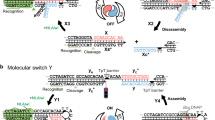Abstract
DNA helicases are ubiquitous enzymes that unwind double-stranded DNA1,2,3. They are a diverse group of proteins that move in a linear fashion along a one-dimensional polymer lattice—DNA—by using a mechanism that couples nucleoside triphosphate hydrolysis to both translocation and double-stranded DNA unwinding to produce separate strands of DNA. The RecBC enzyme is a processive DNA helicase that functions in homologous recombination in Escherichia coli; it unwinds up to 6,250 base pairs per binding event and hydrolyses slightly more than one ATP molecule per base pair unwound. Here we show, by using a series of gapped oligonucleotide substrates, that this enzyme translocates along only one strand of duplex DNA in the 3′ → 5′ direction. The translocating enzyme will traverse, or ‘step’ across, single-stranded DNA gaps in defined steps that are 23 (±2) nucleotides in length. This step is much larger than the amount of double-stranded DNA that can be unwound using the free energy derived from hydrolysis of one molecule of ATP, implying that translocation and DNA unwinding are separate events. We propose that the RecBC enzyme both translocates and unwinds by a quantized, two-step, inchworm-like mechanism that may have parallels for translocation by other linear motor proteins.
This is a preview of subscription content, access via your institution
Access options
Subscribe to this journal
Receive 51 print issues and online access
$199.00 per year
only $3.90 per issue
Buy this article
- Purchase on Springer Link
- Instant access to full article PDF
Prices may be subject to local taxes which are calculated during checkout




Similar content being viewed by others
References
Matson, S. W., Bean, D. W. & George, J. W. DNA helicases: enzymes with essential roles in all aspects of DNA metabolism. Bioessays 16, 13–22 (1994).
Lohman, T. M. & Bjornson, K. P. Mechanisms of helicase-catalyzed DNA unwinding. Annu. Rev. Biochem. 65, 169 –214 (1996).
West, S. C. DNA helicases: new breeds of translocating motors and molecular pumps. Cell 86, 177–80 ( 1996).
Ganesan, S. & Smith, G. R. Strand-specific binding to duplex DNA ends by the subunits of Escherichia coli recBCD enzyme. J. Mol. Biol. 229, 67–78 (1993).
Korangy, F. & Julin, D. A. Kinetics and processivity of ATP hydrolysis and DNA unwinding by the RecBC enzyme from Escherichia coli . Biochemistry 32, 4873– 4880 (1993).
Ali, J. A. & Lohman, T. M. Kinetic measurement of the step size of DNA unwinding by Escherichia coli UvrD helicase. Science 275, 377–380 (1997); erratum, ibid 276, 21 (1997).
Roman, L. J. & Kowalczykowski, S. C. Characterization of the adenosinetriphosphatase activity of the Escherichia coli RecBCD enzyme: Relationship of ATP hydrolysis to the unwinding of duplex DNA. Biochemistry 28, 2873–2881 (1989).
Korangy, F. & Julin, D. A. A mutation in the consensus ATP-binding sequence of the RecD subunit reduces the processivity of the RecBCD enzyme from Escherichia coli. J. Biol. Chem. 267, 3088–3095 (1992).
Taylor, A. F. & Smith, G. R. Monomeric RecBCD enzyme binds and unwinds DNA. J. Biol. Chem. 270, 24451– 24458 (1995).
Bianco, P. R. & Kowalczykowski, S. C. The recombination hotspot Chi is recognized by the translocating RecBCD enzyme as the single strand of DNA containing the sequence 5′-GCTGGTGG-3′. Proc. Natl Acad. Sci. USA 94, 6706–6711 (1997).
Chamberlin, M. J. New models for the mechanism of transcription elongation and its regulation. Harvey Lectures 88, 1– 21 (1992).
Korangy, F. & Julin, D. A. Efficiency of ATP hydrolysis and DNA unwinding by the RecBC enzyme from Escherichia coli. Biochemistry 33, 9552–9560 (1994).
Subramanya, H. S., Bird, L. E., Brannigan, J. A. & Wigley, D. B. Crystal structure of a DExx box DNA helicase. Nature 384, 379–383 (1996).
Velankar, S. S., Soultanas, P., Dillingham, M. S., Subramanya, H. S. & Wigley, D. B. Crystal structures of complexes of PcrA DNA helicase with a DNA substrate indicate an inchworm mechanism. Cell 97, 75– 84 (1999).
Korolev, S., Hsieh, J., Gauss, G. H., Lohman, T. M. & Waksman, G. Major domain swiveling revealed by the crystal structures of complexes of E. coli Rep helicase bound to single-stranded DNA and ADP. Cell 90, 635–647 (1997).
Bird, L. E., Subramanya, H. S. & Wigley, D. B. Helicases: a unifying structural theme? Curr. Opin. Struct. Biol. 8, 14–18 (1998).
Mechanic, L. E., Hall, M. C. & Matson, S. W. Escherichia coli DNA helicase II is active as a monomer. J. Biol. Chem. 274, 12488– 12498 (1999).
Acknowledgements
We thank D. Anderson, R. Ando, D. Arnold, C. Barnes, R. Baskin, F. Chedin, F. Harmon, J. Kleiman, J. New, E. Seitz, and S. Shetterley for their comments. This work was supported by a grant from the NIH.
Author information
Authors and Affiliations
Corresponding author
Rights and permissions
About this article
Cite this article
Bianco, P., Kowalczykowski, S. Translocation step size and mechanism of the RecBC DNA helicase. Nature 405, 368–372 (2000). https://doi.org/10.1038/35012652
Received:
Accepted:
Issue Date:
DOI: https://doi.org/10.1038/35012652
This article is cited by
-
Finding of widespread viral and bacterial revolution dsDNA translocation motors distinct from rotation motors by channel chirality and size
Cell & Bioscience (2014)
-
One motor driving two translocases
Nature Structural & Molecular Biology (2010)
-
Escherichia coli RecBC helicase has two translocase activities controlled by a single ATPase motor
Nature Structural & Molecular Biology (2010)
-
Non-hexameric DNA helicases and translocases: mechanisms and regulation
Nature Reviews Molecular Cell Biology (2008)
-
When a helicase is not a helicase: dsDNA tracking by the motor protein EcoR124I
The EMBO Journal (2006)
Comments
By submitting a comment you agree to abide by our Terms and Community Guidelines. If you find something abusive or that does not comply with our terms or guidelines please flag it as inappropriate.



